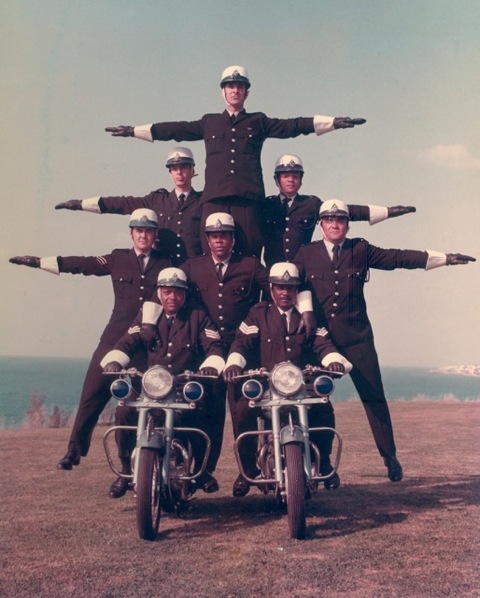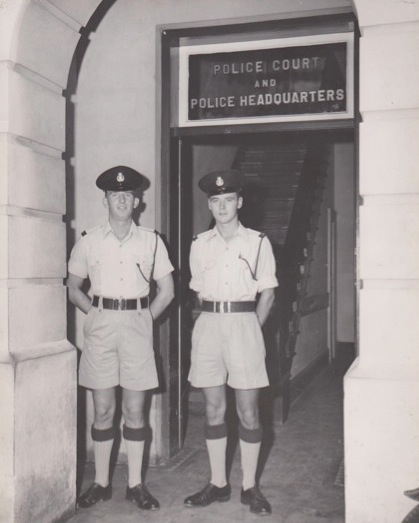
Prior to November 1961 motorcycle escorts for ceremonial and other occasions were provided by officers from the then Traffic Branch. Chief Superintendent Frank Williams felt that the same group of officers, riding the same bikes on all of these occasions and knowing the capabilities of the others, would provide uniformity and present a professional image. To this end he called for volunteers to join this proposed new escort and ultimately a display team. Sergeant Derek Selby, at that time a Sergeant in Traffic was given charge of this new escort which had its first official outing when the then Governor, Major-General Sir Julian Gascoigne and Lady Gascoigne were escorted in their horse-drawn open carriage from Government House to the Cenotaph on Front Street for the November 11th Memorial Day Service.
That first escort revealed that our new Governor was a stickler for punctuality. It had been made known to us that the timing of their arrival at the front of the Colonial Secretariat should only allow sufficient time to enable the Governor and Lady Gascoigne to alight, the Governor then walking the short walk to the Cenotaph to inspect the Guard of Honour. After his inspection, it was important that he did not have to wait more than was deemed necessary before the bugler played the ‘Last Post’ at precisely 11am signifying the commencement of this evocative memorial service. After the traditional one minute silence, the Governor would then take the salute as the Veterans marched past. I can assure you dear reader that trying to control the pace of the horses on this long escort was indeed quite a challenge if, for example, we realized we were travelling too fast and had to slow the pace of the horses. It was not unknown when this happened that the hooves of the leading horse would sometimes strike the rear number plate of the last rider of the escort, usually Tom Cassin!
Frank Williams had received a training programme used by the London Metropolitan Police Motorcycle Precision Riding Team, almost identical to the one used by the famed British Army Royal Corps of Signals Motorcycle Display Team, and he proposed a volunteer team of eight members with two reserves. So early in the New Year training of the Display Team commenced, although Derek Selby was the Sergeant i/c the Escort Unit, I seem to recall it was Peter Edney who conducted the training of the Display Team.
The original team members comprised Sergeants Edney and Derek Selby, Constables Brian Flook, George Goddard, Jim Lyons, Wilf Peacock, R.C.S ‘Bob’ Smith and Peter Stubbs. The two reserves were Freddie Aubrey and Ron Woodhouse, and later members were Sergeant Eric Simpson, Constables Tim Burch, Tom Cassin, Lyn Hall and Harold Moniz. All experienced motorcyclists – Tim Burch an ex Military Police dispatch rider in Malaya and the Canal Zone, Peter Edney a former Hampshire Constabulary Traffic Patrol office, also former Military Policeman, and Jim Lyons an experienced scrambles rider on his Greeves scrambler.
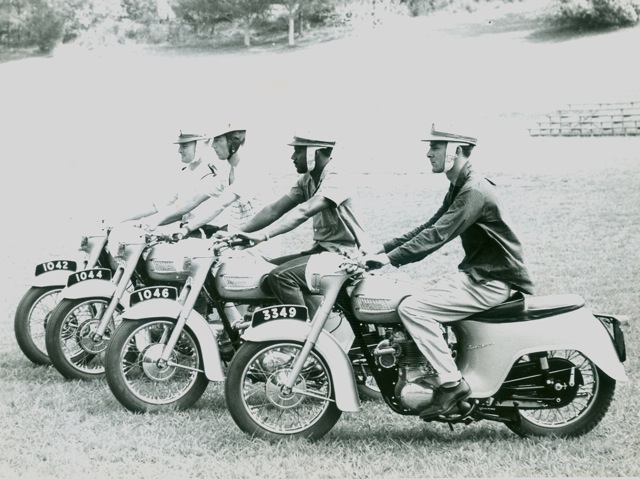
Harold Moniz, who some of us had chased as he sped around the Island on his Motom auxiliary cycle as a teenager prior to joining the Force, had to wait until he was 21 years old before he could be accepted because the Traffic Act did not allow a person under that age to ride a motorcycle with gears! Bob Smith and Eric Simpson were both former District Motorcycle Patrol officers.
Frank Williams took a very keen interest in this complete departure from normal police work, actively encouraging the team in its efforts to emulate both the ‘Met’ and the Signals. He authorised the use of the latest model Triumph 350 cc, (the older ‘Speed Twins’ were too big, and not enough left for our needs). I had watched the Signals perform at Prospect back in 1957 and realised their professionalism derived from the fact that they did their act full time, whereas we were fulltime serving officers, and training part time around the demands of the three shifts we all worked.
Learning the quite extensive list of the various manoeuvres involved at first all seemed a little strange as we practiced these intricate moves at Prospect. Strange because at first we walked the moves and whilst practicing the ‘cross over’, in which four members ride counter clockwise, the other four then ride through this circle and each passing to the rear of the rider riding at right angles to yourself, we would manage to walk into another ‘rider’. But no one dropped out and we persevered, constantly practiced and improved our skills, then as we mastered one manoeuvre we would then move onto another.
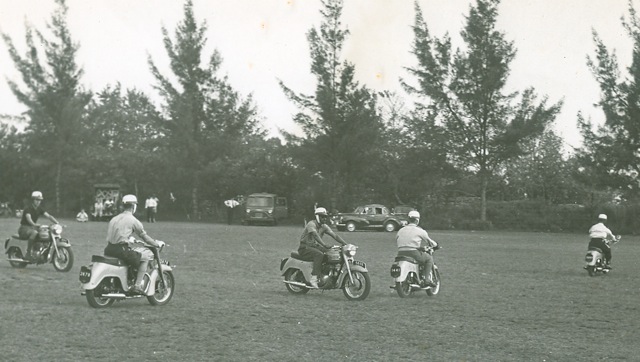
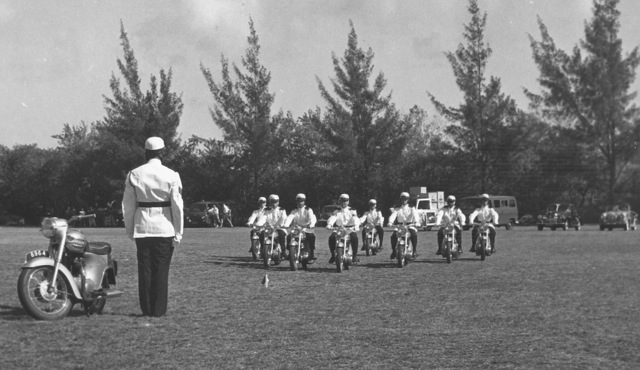
A contemporary account from an article in the Bermuda Police Magazine reads:
‘Following a tight training schedule the team progressed from flying cross-overs and jumps and had perfected trick riding stunts – riding one on a bike, two then three, two on a bike fore and aft, one foot, one hand and no teeth and many other tricks which kept spectators in their seats until they finally circuited the field with the entire team mounted on two bikes!’
We wore our distinctive crash helmet, not our regulation issue helmet as it was found the peak on that helmet restricted vision when performing our ‘stunts’. My son Kirk is now the proud owner of my old helmet.
The team, with some minor changes in personnel, also became the Governor's escort with our first public outing of that year when we later escorted the Governor and Lady Gascoigne to the Hamilton Cathedral service at Easter, and in May of that year we had our first public outing at the Road Safety Week at Prospect.
January also saw the introduction of our new Ceremonial uniforms, a white ‘Prussian’ jacket worn with our winter issue Navy-blue long pants, flat caps for Operations officers and that unique headdress of the British police, the ‘Bobbies’ helmet for all other uniformed officers. This helmet came with a new badge, being identical to the one in use by British Police except the wording read, ‘Bermuda Police’ but for a little while longer we retained our old cap badge. Changing the badge was a very unpopular decision as the old badge was unique and had remained unchanged for many, many years. Later when he became Commissioner, one of the first things ‘Nobby’ Clark did was to revert back to the old badge. I smile here as all officers above the rank of Inspector were now required to wear a sword when in ceremonial dress.
For reasons which I now have absolutely no idea the Commissioner held a parade to display this new dress and I see by the date on the photograph. it was January 1962. This display became an annual event each October when the Police paraded before the Parliament at Prospect. I think that Commissioner Robins wanted to show Bermuda that we could also don ceremonial dress and be just as smart as the two local Forces regiments when they wore their ceremonial dress.
In the late autumn of the previous year the Islands afternoon paper, The Mid-Ocean News commenced ‘The Mid-Ocean News Safety Contest’, in which they invited young Bermudian students to submit a slogan or essay on road safety. Winning entries would be awarded their prizes on the ‘Aunt Nell Basset’s Junior Club TV Show’ and little did I know that only some few months later I, too, would appear on her show. Many of the winning entries displayed a maturity that we as adults often fail to recognize when talking to young children, and I was to remember and consider this fact later in my future role in road safety.
I and others in the force were not privy to what went on as a result of this contest, I’m sure that Commissioner Robins saw here an opportunity to engender a change in which Bermudians viewed their police.
So in the early spring the Commissioner issued a press release to the media with a view to promoting road safety awareness, to which end he suggested a public meeting be held of all interested parties to formulate a ‘Road Safety Week’. Looking back as I write I now realize it was his intention to break down the ‘them and us’ situation which existed between the police and Bermudians of all races. Of course road safety in any community that has motor vehicles will always stir people’s emotions, and any action taken to reduce road trauma is welcome. As I was to learn years later when working with the Queensland Road Safety Council, politicians like to be seen endorsing any road safety initiative as there are votes in it, unlike increasing fuel tax or the cost of a Drivers Licence.
This public meeting was held at the Chamber of Commerce and attracted over fifty delegates and represented a very fair cross-section of Bermudian society. Amongst these were representatives from the USAF, US Navy, Department of Education, Transport Control Board, Lions and Rotary Clubs, both the Chamber and Junior Chamber of Commerce, Service clubs such as the Pilot Club, Altrusa Club and others. The Commissioner outlined the purpose of this forthcoming week and suggested a number of committees would be necessary to organize the event then, after proposing a Steering Committee to organize then oversee the committees, he stepped back and very adroitly proposed that Chief Superintendent Frank Williams be the Police representative, which was accepted.
I was to discover that Bermuda was full to overflowing with ‘experts’ in road safety and, with many years of experience in the field of road safety behind me I know it is a common theme. It was interesting to hear comments such as ‘there should be a law against that’ when in fact there was. Only the speaker and most of the audience listening were blissfully unaware that there was!
It is always ‘that other fool on the road’ who needs to be ‘taught how to drive’ safely, never the person talking about ‘that fool’ and, years later in Queensland, I found nothing had changed. One outspoken person in the form of Doctor Eugene Walker declared that an example should be set by the ‘higher ups’, indeed on one occasion he had observed an official car ‘parked on the road facing the wrong direction!’ and also commented on policemen who were riding their cycles well above the speed limit ‘going back to breakfast’ (presumably from the Hamilton Central Station to the mess at Prospect). A public forum is always a good place to throw stones isn’t it?
Well, just as Commissioner Robins had named Frank Williams to be the Police representative, he in turn summoned yours truly and Peter Stubbs to inform us that, as the first ‘Road Safety Officers’ in the history of the Force, we would now put our knowledge of such to good use and liaise with the various sub-committees and assist in organizing the forthcoming ‘Road Safety Week’, for which the third week in May had been chosen. Oh and by the way, we would also be required to visit all schools on the island to conduct bicycle safety checks, give road safety talks and also prepare notes for the Divisional Sergeants when they visited schools in their respective areas.
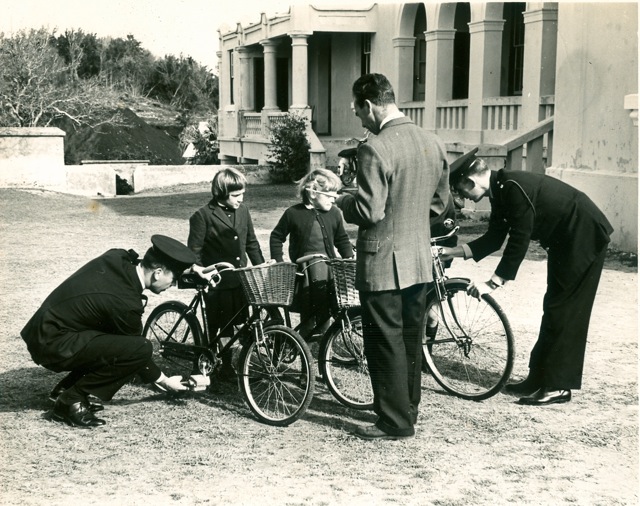
When not engaged in those activities we were also required to write, then record road safety messages to be aired by each of us on the local radio station ZBM, and assist in judging the competition entries in the various age groups for which certificates would be awarded to the winning entries. The winning slogan adopted for this week was – ‘COURTESY is the KEY’ and one entry for a jingle which I thought amusing was –
As we say in Australia, this thing ‘became bigger than Ben Hur’, but it wasn’t all that hard. It was certainly a very pleasant change from attending ‘domestics’, picking broken bodies off the road, dealing with drunks or others who wanted ‘to take you on’. Previous service with my tank regiment came in handy as we scrounged and wheedled for assistance or promises of material for this project. It was interesting; here we were, two Constables liaising with the captains of industry, senior government departmental officers and treading a fine line when discussing with coloured and white Service clubs their contribution to this forthcoming event. Chief Superintendent Frank Williams had given us ‘carte blanche’ to organize and work our own hours, with access to any vehicle(s) we needed, with the proviso that the respective Duty Operations Sergeant knew where to contact us should the need arise, so we always went ‘on air’ when using any Tango vehicles.
Support from the various committees was excellent and the culmination of all this planning and co-operation from local businesses was to be held at the old Military Stadium, ‘Garrison Field’ at Prospect, now the National Stadium. It was here that when preparing a short ‘road circuit’ we had under our ‘command’ the last of the UK trained officers (our Training School had now commenced the training of all new recruits). I recall Nick Hall, Bob Leitch and Marjorie Wainwright and others all finding the somnolent heat of the late Spring somewhat hard to endure as we finalized the layout.
The highlight of the ‘Road Safety Week’ was held on a Thursday afternoon, this day being ‘half-day closing’ for businesses on the Island, and to the ‘Forty Thieves’, despite their outward show of altruism, commerce was money! In front of an assembled audience of the Governor, Members of Parliament, ‘assembled dignitaries’ as the press throughout the world are wont to describe them, members of the general public, and with Sergeant Ken Morris as MC, the ‘curtain’ went up and our ‘show’ commenced.
After a short display by the Display Team (our first public outing), younger groups of children displayed their knowledge of the safest way to cross a street, with or without a pedestrian crossing, then older children demonstrated the correct way to mount a bicycle (from the left), then went on to further display their skills as they rode their bicycles around our ‘road circuit’.
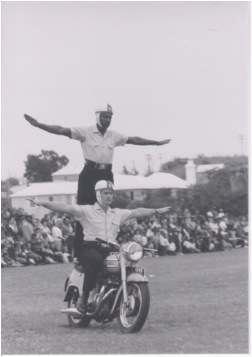

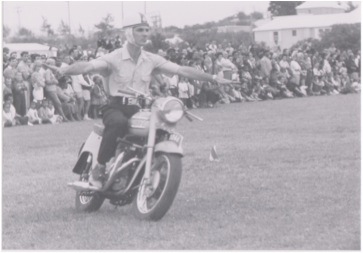
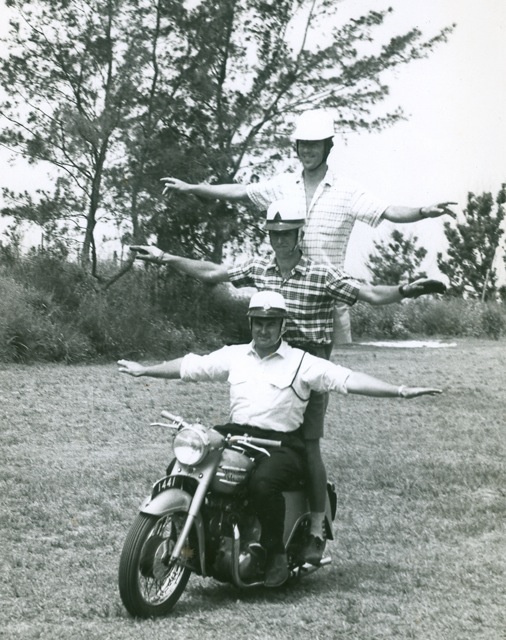
But the highlight of the show was our ‘Road Safety Car’ which could ‘drive’ quite safely and obey all the ‘road’ rules without a driver! It was an old Austin A35, about the size of a Mini, donated by the BMC agents, Pearman Watlington Company (our biggest scrounge!) and they had removed the seats. This enabled the ‘driver’, Tom Cassin, to lie down and out of sight, then Ken Morris, using a loudhailer would command the car to drive off. Tom would manipulate the foot pedals by hand, the accelerator being set just above idling speed and he would steer using a combination of commands from Ken and the use of a small periscope we had fitted. It certainly impressed the gathered throng and we later used it on a number of occasions throughout the island.
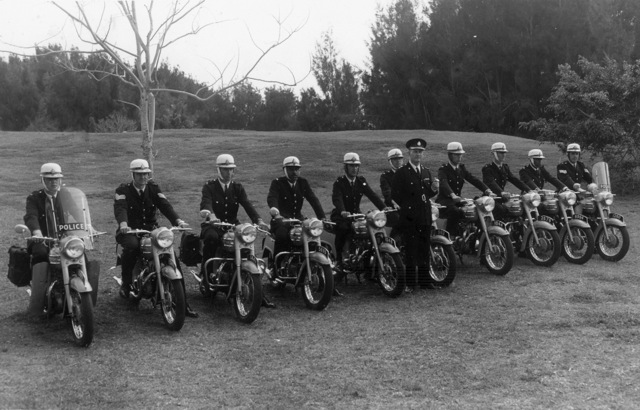
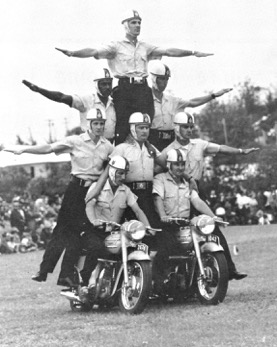
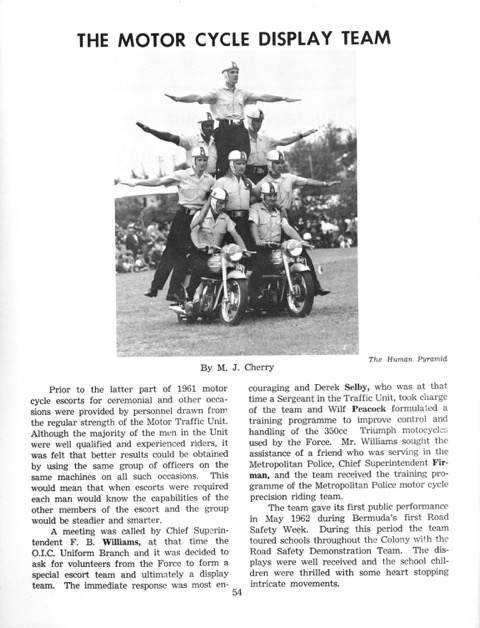

EDITORS NOTE - In January 2021 we published an article about what was a once-in-a lifetime display in Bermuda by the Royal Canadian Mounted Police, together with a display by our own Bermuda Police Motor Cycle Display Team, which was held at the BAA Field in October 1969.
This spectacular exhibition was hosted by the Bermuda Horse and Pony Association on the occasion of the Association’s Annual Show.
CLICK HERE for the article about this unique event.
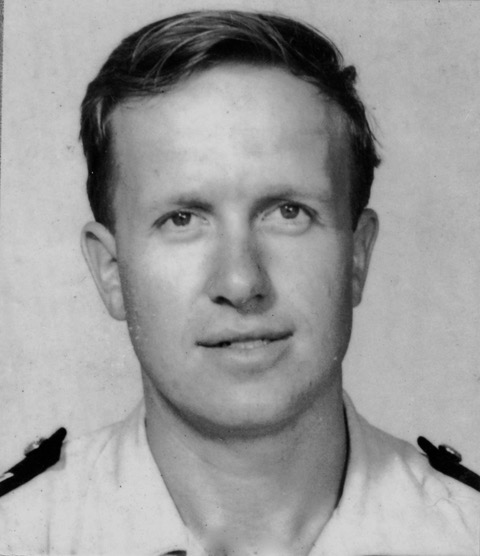
Shortly after we published the article about this special event involving the Royal Canadian Mounted Police and our Bermuda Police Display Team, we received the following message from our good friend Mike Cherry who had written the above article for our Police Magazine:
"I have just re-read the article on the visit by the RCMP and the subsequent articles about the Police Motor Cycle Display team, one written by George Goddard apparently in 2017, and the other written by myself in 1963.
I had forgotten about the latter article, and had not seen the one written by George before.
George and I were good mates from the time when I was transferred to Traffic in 1961 when we were co-drivers, sharing a Sunbeam Talbot and a Triumph 500cc motorcycle.
Although I was a keen motor cyclist before coming to Bermuda I did not get involved with the display team due to a lack of suitable training time, probably because of my involvement at that time with the Squash Association and the development of the courts.
From the age of 16, and still at school I was a proud owner of a BSA Bantam on which I travelled extensively, and was even featured in an advert in the Motor Cycle magazine, a popular weekly publication.
The 500cc Triumphs were not suitable for the display team, and we were fortunate in getting the smaller and more manageable 350cc models.
George and I were good friends and I was best man at his wedding when he wed Jeannie Franklin, a co-worker of my wife Anne at Pan Am Airways. Incidentally Jim Hanlon’s wife Joan was also a co-worker of Anne and Jeannie. So not all policemen married nurses.
I was also involved with Road Safety lectures after promotion and transfer to Western Division, when I was Parish Sergeant and had a 250cc BSA to use, visiting schools and other duties.
I was also involved with a Motor Gymkhana held at White Hill Field, which was sponsored by Lord Essex who had a house in Southampton. I do not remember too much of the details but as well as pedal cycles, and motor cycles, car drivers were encouraged to show their driving accuracy skills rather than speed. Some of the “diddly bop” drivers and riders came in for a shock.
CLICK HERE for Mike Cherry's excellent "Then and Now" article on our ExPo website.
EDITOR NOTE - We have subsequently added this excellent photo of members of the Police Motor Cycle Display Team taken during the late 1960's.
